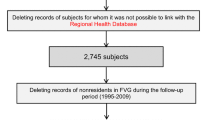Abstract
Aim
The purpose of this study was to compare site-specific cancer death rates in male workforce across major occupational groups in Greece.
Methods
Data on cancer mortality in men aged 25–69 years during the period 2000–2005 were obtained from National Statistical Service of Greece. Age- and site (ICD-10)-specific cancer death rates and the ratio of standardized cancer death rates (i.e. the comparative mortality ratio and 95% confidence interval) across seven major occupational groups (ISCO-88) were calculated.
Results
The proportion of total deaths due to cancer was ranged between 6.6, 24.3, 37.4, and 39.4% for the age groups of 15–39, 40–49, 50–59, and 60–69 years, respectively. Respiratory and gastrointestinal malignancies constituted 70% of the total cancer mortality in our population. Groups of elementary occupations, skilled agricultural workers, and plant workers showed very high mortality ratios of respiratory cancer while low ratios were found for the groups of professionals, legislators, senior officials, and managers and paradoxically for craft and related workers. Compared to the other groups, skilled agricultural and elementary groups showed higher rates of gastrointestinal and other or no determined malignancies in the age groups of 40–49 and 50–59 years old. Plant workers and machine operators/assemblers exhibited high mortality rates for most cancer sites especially in the elders group (60–69 years) and a mortality ratio of genitourinary cancer that differed significantly compared to any other group.
Conclusions
Up to 3.5-fold variations were found in site-specific cancer mortality ratios among men in Greece across broad occupational groups. The extent of the variation attributed to specific socioeconomic and/or occupational factors could not be estimated in the current study but the observed differences might stimulate thinking and preventive actions as well as point to potential hypotheses to pursue using research methods in which job and life related factors should be directly measured and controlled.
Similar content being viewed by others
References
Ahmad OB, Boschi-Pinto C, Lopez AD, Murray CJL, Lozano R, Inoue M (2001) Age standardization of rates: a new WHO world standard Geneva, Switzerland, WHO, GPE discussion paper series: no. 31 EIP/GPE/EBD
Alexopoulos EC (2008) Re: Age at retirement and mortality in a general population sample: the Greek epic study. Am J Epidemiol 168(8):974–975
Alexopoulos EC, Geitona M (2009) Self-rated health: inequalities and potential determinants. Int J Environ Res Public Health 6(9):2456–2469
Blair A, Rothman N, Zahm SH (1999) Occupational cancer epidemiology in the coming decades. Scand J Work Environ Health 25(6):491–497
Boffetta P, McLaughlin JK, la Vecchia C, Autier P, Boyle P (2007) ‘Environment’ in cancer causation and etiological fraction: limitations and ambiguities. Carcinogenesis 28(5):913–915
Boot CR, Heijmans M, van der Gulden JW, Rijken M (2008) The role of illness perceptions in labor participation of the chronically ill. Int Arch Occup Environ Health 82:13–20
Colditz GA, Atwood KA, Emmons K, Monson RR, Willett WC, Trichopoulos D et al (2000) Harvard report on cancer prevention volume 4: Harvard cancer risk index. Cancer Causes Control 11:477–488
Faggiano F, Partanen T, Kogevinas M, Boffetta P (1997) Socioeconomic differences in cancer incidence and mortality. IARC Sci Publ 138:65–176
Jelastopulu E, Merekoulias G, Alexopoulos EC (2010) Underreporting of communicable diseases in the prefecture of Achaia, western Greece, 1999–2004–missed opportunities for early intervention. Euro Surveill 15(21):19579
Joumard I, Andre C, Nicq C, Chatal O (2008) Health status determinants: lifestyle, environment, health care resources and efficiency. Economics department working paper, no. 627, OECD Publishing, Paris
Kjaerheim K, Martinsen JI, Lynge E, Gunnarsdottir HK, Sparen P, Tryggvadottir L, Weiderpass E, Pukkala E (2010) Effects of occupation on risks of avoidable cancers in the Nordic countries. Eur J Cancer 46(14):2545–2554
Kogevinas M, Kauppinen T, BoVetta P, Saracci R (1998) Estimation of the burden of occupational cancer in Europe. Final report to the European commission of a project funded by the programme “Europe against cancer”. IMIM, Barcelona
Kunst AE, Mackenbach JP (1994) International variation in the size of mortality differences associated with occupational status. Int J Epidemiol 23(4):742–750
Kunst AE, Groenhof F, Mackenbach JP, The EU Working Group on Socioeconomic Inequalities in Health (1998a) Occupational class and cause specific mortality in middle aged men in 11 European countries: comparison of population based studies. BMJ 316:1636–1642
Kunst AE, Groenhof F, Mackenbach JP (1998b) Mortality by occupational class among men 30–64 years in 11 European countries. EU working group on socioeconomic inequalities in health. Soc Sci Med 46(11):1459–1476
Makropoulos V, Alexopoulos EC (2006) Case report: hydroquinone and/or glutaraldehyde induced acute myeloid leukaemia? J Occup Med Toxicol 1:19
Marmot M (2005) Social determinants of health inequalities. Lancet 365:1099–1104
Naud C, Brugére J (2003) La reconnaissance des cancers professionnels en Europe [Recognition of occupational cancers in Europe]. BTS Newsl 21:42–43
NSSG (1998) Labour force survey http://www.statistics.gr/portal/page/portal/ESYE/BUCKET/A0101/Other/A0101_SJO01_MT_QQ_01_1998_04_2009_01_F_EN.pdf
Siemiatycki J, Richardson L, Straif K, Latreille B, Lakhani R, Campbell S et al (2004) Listing occupational carcinogens. Environ Health Perspect 112:1447–1459
Steenland K, Burnett C, Lalich N, Ward E, Dying HurrellJ (2003) Drying for work. The magnitude of US mortality from selected causes of death associated with occupation. Am J Ind Med 43:461–482
Vineis P, Simonato L (1991) Proportion of cancers in males due to occupation: a systematic approach. Arch Environ Health 46:6–15
Acknowledgments
We wish to thank the staff of National Statistical Service (now Hellenic Statistical Authority) for their administrative help.
Conflict of interest
The authors declare that they have no conflict of interest.
Author information
Authors and Affiliations
Corresponding author
Rights and permissions
About this article
Cite this article
Alexopoulos, E.C., Messolora, F. & Tanagra, D. Comparative mortality ratios of cancer among men in Greece across broad occupational groups. Int Arch Occup Environ Health 84, 943–949 (2011). https://doi.org/10.1007/s00420-011-0622-y
Received:
Accepted:
Published:
Issue Date:
DOI: https://doi.org/10.1007/s00420-011-0622-y




